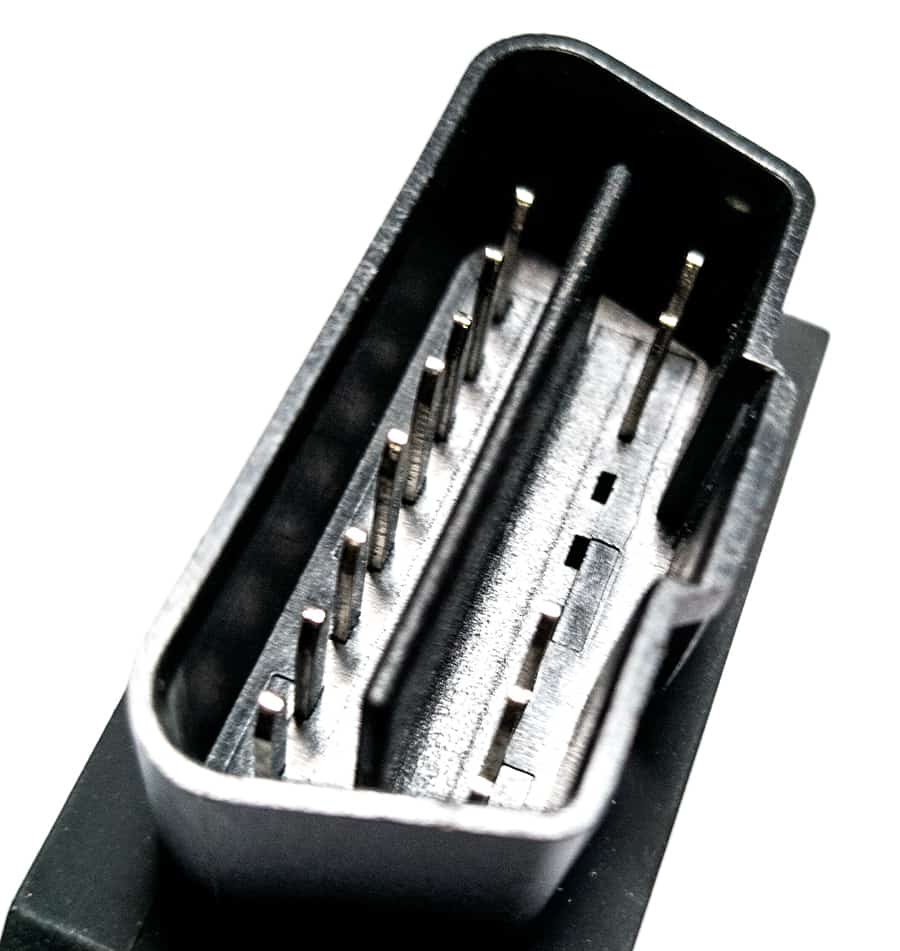
Above: The business end of bmobile’s Car Hub device. Photo by Mark Lyndersay.
BitDepth#1145 for May 17, 2018
bmobile quietly announced the availability of a new product and service last week, a remote monitoring service for vehicles equipped with an Onboard Diagnostic Port, or ODB II.
This is an access point installed in all modern vehicles, specifically those made from 1996 onward, but basic error reporting has been available in vehicles for decades (Volkswagen introduced the feature in 1968), normally showing up as a blinking light that alerted drivers to an issue with the machine they are piloting.
The ODB II is a digital port, one that mechanics will plug into with a handheld scanner to get a quick overview of what a vehicle’s sensors are reporting.
The new Car Hub service from bmobile puts some of that advanced capability in the hands of local drivers, though for many, it might be a solution in search of a problem.
You plug the rather industrial box into the car’s ODB II port, which can be a bit of a challenge, since it’s usually neatly tucked away, usually under the steering wheel.
My port was right at the base of the dashboard assembly, unnervingly close to the accelerator, but in practice proved to be no bother at all.
An app, available on both the Apple and Google app stores, communicates with the device in real time, should you wish to be nagged on a moment by moment basis about your failures as a driver (you’ll need to have the app open to see the alerts).
Car Hub reports a driving score, which is an overall rating of the quality of your driving, the results of your driving style, which can effect mileage and fuel consumption, the location of your vehicle, trip history, and on modern vehicles, diagnostic trouble codes transmitted by the engine control unit.
It also logs bad driving behaviour such as harsh braking, acceleration and cornering along with driving indicators that suggest a tired driver.
If that sounds a bit like having your mom permanently in the car with you, well that’s one obvious use of the device.
Making continuous logging of the use of a car a requirement of access for a new, youthful driver might prove to be useful for either raising warning signals for or placating a worried parent putting a powerful machine in the hands of their child.
The device doesn’t provide security services beyond noting that the vehicle is in use. For that you need a service like CyloTracking.
The other clear case for the device is for monitoring the use of fleet vehicles, but this particular device and app seem a bit lightweight for that use.
According to bmobile, “All fleet data is available to the customer for up to one year and can be exported from the platform. From driving behaviour, fuel mileage and consumption, trip data, mileage data, vehicle fault codes, and consumable vehicle costs.”
There is also a supplementary specification for heavy commercial vehicles, HD-OBD, that may call for a different approach for information logging. bmobile notes that the Car Hub product is intended for use in cars and light trucks.
Enterprise users will also want to log and crunch data in much greater detail than the app offers, so that’s likely to be a different market and product entirely.
It’s also unclear whether bmobile intends for this to be a closed system. ODB II keys are available on the market which are more aggressive in the features they offer as well as in the style and richness of reporting.
Having installed a black box (it’s actually dark grey) in your car, the deal is sweetened significantly by the addition of in-car WiFi services, which are part of the system.
On the basic plan, which costs $100 per month (after paying $1,000 for the device), you get 3GB of data on the vehicular WiFi. For $299 you can increase the data plan to 40GB.
Reception tracks closely with what you’d experience trying to use 4G internet services in a moving vehicle using a smartphone. I got wildly different download rates in Port-of-Spain alone, ranging from .9Mbps to 8Mbps, so your data mileage will definitely vary.
According to the device, I manage a fuel consumption rate of 16.8 kilometres per litre, tend rather vigorously toward harsh acceleration (my car responds like a well-fed toad, so there) and have a driving score of 43.27, which is a bit low, but I’m blaming that uncooperative accelerator pedal.



